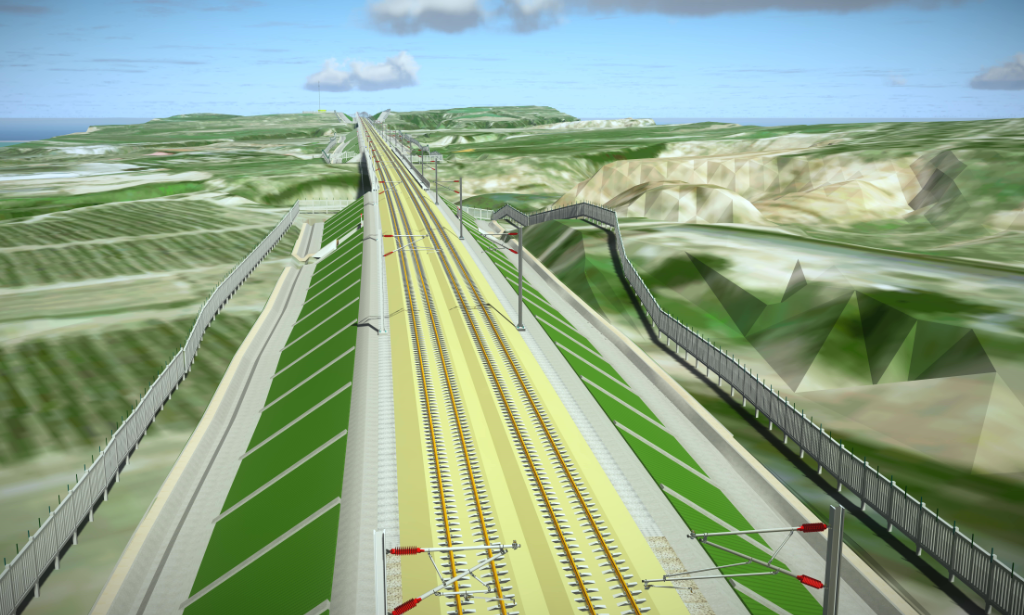China Railway Sets Benchmark for Full-lifecycle BIM on Beijing-Zhangjiakou Rail Project
by Steve Cockerell, Director Industry Marketing – Road and Rail, Bentley Systems
A World-class High-speed Railway
As part of China’s national railway construction initiative, and in preparation for Beijing to host the 2022 Winter Olympics, the Beijing-Zhangjiakou high-speed railway is being constructed in the Hubei province of northeast China. The CNY 53.5 billion, 174-kilometer long railway will become the world’s first high-speed rail line with a design speed of 350 kilometers per hour. It will reduce travel time between the two city venues for the Olympic Games from three hours to 50 minutes. With 71 subgrade sections, 64 bridges, 10 tunnels, and 10 stations, including the world’s deepest and China’s largest underground station at Badaling, the new high-speed line will be the first in China’s rail industry to adopt a full-lifecycle BIM strategy for all disciplines involved in the project.
China Railway Engineering Consulting Group (CEC) was responsible for preliminary and detailed design and construction consulting. Setting a goal to establish a benchmark in the railway industry, the company committed to using innovative technology methods to optimize design and construction and achieve full-lifecycle BIM on the world-class high-speed rail project. With 23 main engineering disciplines and 56 design sections, the team faced many challenges on this complex project. The project presented significant and changing environmental conditions in a high-altitude area amid surrounding cultural infrastructure that required complicated structural solutions. To optimize design, efficiently coordinate the project, and implement effective 3D collaborative design and construction processes, CEC needed integrated digital design applications.
Establishing a Connected Data Environment
To facilitate coordinated design and engineering processes, CEC selected Bentley technology to establish an open, connected data environment (CDE). “We are facing big problems in collaboration, so we want to find an amazing platform that is easy to use, provides a uniform data storage format, and supports collaborative work,” said Zhongliang Zhang, director of BIM at CEC. Based on ProjectWise and Bentley’s integrated design applications, the team created
logical links between and within the different disciplines, providing real-time access to trusted information wherever and whenever required. CEC relied on ProjectWise as the common platform and implemented innovative BIM methodologies using MicroStation, OpenBuildings Designer, and OpenRoads Designer to optimize information exchange. The integrated software solution allowed the team to create a component library to standardize design and dynamic modeling that could be centrally managed at all stages, in the same digital collaboration environment, and in accordance with the same standards.
Using Bentley’s CDE with a unified underlying data structure optimized exchange and integration of the various data types across the different engineering specialties involved, resulting in rapid model development. The connected digital solution significantly improved work efficiencies for the teams involved, with CEC using Bentley software to create a coordinated environment to enable multidiscipline design and collaboration, as well as to improve the quality of generated deliverables.
Advancing BIM for Optimal Design
CEC utilized Bentley applications, advancing 3D BIM capabilities in a CDE for coordinated design solutions to overcome the numerous site constraints. Importing high-speed rail specifications into OpenRoads assisted designers in determining industry-compliant design
elements and establishing a standard basis for design. Bentley’s diversified modeling capabilities and data representation optimized geological design mapping and developed standardized structural components for the bridge and track. Given the architectural complexities of Qinghe Station and the excavation difficulties of the Badaling Station and tunnel, CEC worked with Bentley to maximize the digital potential of BIM workflows and to optimize design through automation, consistency, and intelligent processes.
Qinghe Station
The largest station along the Beijing-Zhangjiakou high-speed rail line, Qinghe Station spans more than 138,000 square meters with simple and powerful curves and supporting structures that highlight Beijing’s ancient charm and modern appearance. The complicated architecture required geological analysis, construction of a foundation pit, and a comprehensive piping system. The building adopted a combination of A-shaped, Y-shaped, and straight columns to support the 160-meter, long-span steel structure and cantilevered roof. Using Bentley’s integrated BIM applications, CEC carried out multispecialty design, visualizing all the model components and integrating them into a comprehensive 3D model. The team conducted collision detection to resolve any issues prior to construction, and the innovative design generated with Bentley technology allowed the team to reduce noise interference associated with the surrounding buildings.
Badaling Station and Tunnel
The Badaling Station and Tunnel traverse the scenic and cultural area that includes a section of the Great Wall of China. The construction area and depth of the station are record-breaking, spanning 36,000 square meters, located 102 meters below ground, and the tunnel to access the
station is 12 kilometers long, making it the longest tunnel along the rail line. Both structures required difficult excavation to avoid cutting through the Great Wall and to accommodate the poor geological conditions of the area, which is vulnerable to flooding. The team used Bentley’s
BIM technology to facilitate multidiscipline modeling and automate manual tasks. Using MicroStation, OpenBuildings Designer, and OpenRoads, the different design specialties
modeled the underground facilities and excavation stands at both ends of the station. Bentley’s flexible and interoperable applications supported the stations’ design service life of 100 years, allowing the team to verify comparability and comprehensiveness of the circular rescue corridor, which is capable of rapid and dead-end rescue in emergencies.
“In general, applying Bentley BIM modeling provides a simple and efficient process and helps us take the first step in BIM design,” Zhongliang said. Through automated, standardized,
and intelligent collaborative design methods, CEC went beyond the first step, advancing the capabilities of BIM to deliver innovative, coordinated railway design and lay the foundation for construction operation and maintenance, for full-lifecycle BIM processes.
Collaborative Technology Solution Delivers Benefits
To realize multidiscipline design, CEC used Bentley’s integrated technology to develop 3D collaborative BIM processes, standardizing data structure for modeling and design purposes, and streamlining workflows. The company used the software to perform altitude calculations and
3D model integration in accordance with China Railway Engineering standards. The parametric modeling features facilitated efficient change management and automated 3D model generation, optimizing design while shortening modeling times. Working in a CDE enabled real-time unobstructed access to and exchange of project information. The common file format facilitated collaboration across all disciplines and reduced data transfer costs and risk throughout all phases of design.
More specifically, CEC resolved design and layout issues with pipelines and underground structures and reduced geological modeling time by six months compared to traditional methods. Using Bentley’s applications for 3D multidiscipline design coordination and modeling resulted
in optimized land use during construction and reduced environmental impact while still meeting the railway’s technical requirements. The collision detection features identified design errors prior to construction, which enhanced design accuracy, reduced rework, improved efficiencies, and eliminated costs associated with on-site construction changes. Overall, Bentley’s collaborative digital solution saved three months in design time and CNY 3 million.
A Digital Benchmark for the Future
Based on Bentley’s CDE, CEC is using the Beijing-Zhangjiakou high-speed railway project as an opportunity to verify and approve current BIM standards and set a benchmark for full-lifecycle BIM within China’s rail industry. By exploring 3D design across multiple professions and verifying the feasibility of Bentley’s BIM design capabilities for all railway design specialties, the CEC team reduced the environmental impact of the project and improved the efficiency and quality of the design and deliverables.
Advancing the application of BIM technology in the planning and design phases of railway initiatives, CEC relied on the flexibility and interoperability of Bentley software to facilitate
coordinated modeling of the complex tunnels and stations and lay the foundation for BIM processes during construction, operations, and maintenance. “The Beijing-Zhangjiakou
intercity railway is of great guiding significance to other BIM projects in the railway industry’s future,” Zhongliang said. “By using Bentley’s technology, China Railway Engineering Consulting Group is working toward realizing intelligent construction, equipment, and operation and is the start of a new era for the world’s intelligent railway.”






















 Kuwaiti developer URC signs with Ahmadiah Contracting for the Commercial District development at Hessah AlMubarak
Kuwaiti developer URC signs with Ahmadiah Contracting for the Commercial District development at Hessah AlMubarak